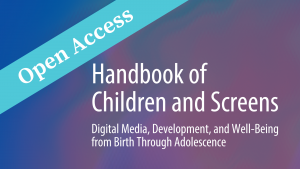
The anonymity and ease of accessing sexual content online exerts a strong lure for adolescents seeking information about sexual topics. Young children are also, many times inadvertently, encountering sexual and sexualized content online they may not yet be developmentally ready for or that contradict values parents are trying to instill. What do parents need to know about the sexual content their children are encountering online, and what are the best ways to communicate and prepare them for what they might see online?
On This Page
What Kids Are Seeing Online
Internet Is a Potent and Popular Source for Adolescent “Sexual Scripts”
It’s common and developmentally appropriate to develop increasing sexual curiosity in adolescence, often before having any personal experience to draw on. In this situation, media is a tempting source of information for adolescents to learn “sexual scripts” in a less potentially embarrassing way than asking parents or other adults in their lives, says Jennifer Stevens Aubrey, PhD, Professor of Communication at University of Arizona.
“Sexual scripts” are socially learned expectations young people form about how people should behave in sexual or romantic situations, including who they think should take the lead, how partners should behave and what is considered normal or desirable. Today’s adolescents are leaning on media – TV, movies, social media, music, or even pornography – to learn these sexual scripts. These sources aren’t necessarily conveying healthy, respectful, or realistic expectations, and youth “may not be learning what parents and educators want them to learn,” says Aubrey.
Media Content Often Portrays Sexual Double Standard
Research indicates that sexuality in digital content largely conforms to a heterosexual script that overlaps with a sexual “double standard,” says Aubrey. “Sex is portrayed as risky for girls, both emotionally and physically, and as such, they [girls] are more likely to receive negative consequences or punishments for sex than boy or male characters. In addition, boys are portrayed as being obsessed with sex, driven by sex, and this is mostly portrayed as a way for boys and men to demonstrate their masculinity to others.”
Most Kids Are Seeing Sexual Content – Intentionally or Not
Children and adolescents who are not necessarily looking for sexual information are still seeing this content regularly, noted several experts. “Depictions of sexual talk and behaviors are quite frequent in entertainment media for youth,” says Aubrey.
“We did a national study where we actually looked at what teens were consuming and what they were being exposed to on online content. We found they were being exposed to sexual content, and they were also being exposed to pornography. Children were pretty disturbed about what they were seeing,” says Carolyn West, PhD, Professor of Clinical Psychology at University of Washington.
Video Games Often Include Sexualizing Content
Content analyses of video games has shown them to be “highly sexualizing” in terms of how female characters are portrayed, says Aubrey. “They’re objectified and there’s a lack of humanity imbued into those characters. Along with that, the body is very much exposed for both male and female characters; they conform to heteronormative and gendered expectations about how bodies should look.” Studies show characters portrayed in highly sexualized ways or primarily as a sex object tend to be less respected by players, even of characters that have agency or “kick butt” in the game, she notes.
Teen Sex is Overrepresented in Media and In Adolescents’ Minds
“There is a rather dramatic overrepresentation of teen sexual behavior in mainstream media,” says Aubrey, in that the percentage of sexually active teens in entertainment media is significantly greater than the percentage of teens who actually have had sex. In addition, portrayals of teen sex in media often depict casual sex relationships or “hookups”, sometimes called “friends with benefits” relationships, she notes, and the sexual behaviors are largely unencumbered by discussions of risks, like the contraction of an STI, for example, and responsibility, which would include taking precautions like using condoms while having sex.
Sexual Content in Media Affects Teen Sexual Attitudes and Behaviors
Research suggests that teens who consume more sexual screen media have more permissive sexual attitudes and also describe their peers as being more sexually active than they actually are, says Aubrey. They are also more likely to endorse a “double standard” attitude for mixed-gender sexual relationships, including:
-
- Consequences of sex: Girls should be punished and boys rewarded for having sex.
- Romantic relationship sexual expectations: For girls, to control timing of sex; for boys, to control the amount of sex.
- More lax perceptions of sexual aggression.
The sexual behavior of teens who consume more sexual media is also different; they tend to start having sex at an earlier age, have a greater number of sexual partners, and more engagement in risky sexual behaviors, shares Aubrey.
Rough Sex Behaviors/Choking is Increasing Online and Offline
The last decade has seen a marked increase in what experts call “rough sex behaviors,” including practices commonly referred to as “choking,” notes Debra Herbenick, PhD, MPH, Provost Professor and Director of the Center for Sexual Health Promotion at the Indiana University School of Public Health-Bloomington. Rough sex is an “imperfect umbrella term” used for a range of behaviors that can include light and hard spanking, sexual choking (which is actually a form of strangulation), smothering, name-calling, slapping, and many other kinds of sex, says Herbenick.
Sexual choking (strangulation) in particular is “never zero-risk,” she says. “Because it involves external pressure to the neck that can restrict blood flow or airflow, it is technically strangulation, and can lead to short-term and long-term health consequences.” Her research indicates around two thirds of women, nearly a third of men, and more than half of transgender and non-binary college students report having been choked, usually consensually. “Our most recent data show that it’s becoming more frequent, more of a normalized part of their sexual repertoire,” she says. “Among random samples of college students who have engaged in choking – 1 in 3 report first engaging in it between the ages of 12 and 17.”
Herbenick’s research indicates that many young people can’t remember where they first heard or learned about choking, because they can think of so many different places they’ve seen or heard about it, from popular TV shows like Euphoria and The Idol to large numbers of TikTok videos on the subject to number one songs that define choking as “vanilla” behavior. Many young women talk about learning about choking from seeing it in internet memes and in online fanfiction. Some of these memes mock the idea of getting consent for choking and conflate it with blurry lines around aggression and violence, says Herbenick.
Romantic Relationships With AI Chat Bots Are Happening
Part of the new era of widely available online and powerful AI tools is the development of personalized AI chat bots for the purpose of having a relationship. These chat bots are designed and programmed to be emotionally supportive and trainable. While usually designed to be a safe environment, romantic relationships with bots are possible, and may offer nudity and sexuality, says Elizabeth Englander, PhD, Director of the Massachusetts Aggression Reduction Center and Professor of Psychology at Bridgewater State University. Because humans are used to train these chat bots, they can be quite realistic, notes Englander.
AI is Making it Easier to Create Fake Nudes From Neutral Photos
AI is quickly changing many aspects of online content, and a big one is how it is changing photo manipulation, as it makes it extremely easy to outline a shape and copy it into another background or for faces and heads to be swapped, says Englander. “There are what we call ‘undress apps,’ which are apps that can remove clothes, or appear to remove clothes, on any photo.”
Taking neutral or innocuous photos and transforming them into something sexual are often called “deepfakes”, “nudefakes”, or “deepnudes”, and there are many apps available that can create hyper-realistic erotic images from photos that are very neutral, notes Englander. While many of these images currently focus on celebrities, the technology can and has been used on non-celebrities.
Tips for Parents
Tips for Parents
Don’t Let the Internet Be Your Child’s Only Sex Educator
While it’s normal for adolescents to be seeking out sexual information online, the content they see may not be fact-based and it may not be teaching them sexual scripts that align with your family values. “They’re going to hear everything. They’re going to see everything. And it’s safer for them to have this information from you,” says Amy Lang, MA, Sexual Health Educator at Birds & Bees & Kids. “You need to empower them with information.”
The most important thing parents and caregivers need to know when it comes to having conversations with kids about sexuality and pornography is an understanding that “you are powerful,” says Lang. “You have the most power and influence over your children’s sexuality education, how they see themselves as a sexual person, and their values. You have a ton of influence.”
The only people who can communicate your family’s values to your children are parents and caregivers, says Englander. “Don’t leave it to the internet to educate them about things like AI girlfriends and boyfriends and whether or not they’re healthy or whether or not changing photos of other people is okay. Bring in your own values about whether these things are right and wrong and offer to talk to your kids about this.”
Protect Kids By Having “The Conversation”
Having talks about sex with children is protective, says Lang, as it gives them a space to learn while also showing them that you know what you’re talking about and that they can trust you and talk to you.
Don’t tell yourself that your kids won’t see porn. “One hundred percent they will see porn,” says Lang. “Think about it in terms of preparation. Talking with your kids about sexuality is really important in terms of helping them manage their pornography exposure. Talking about it decreases curiosity about it.”
Children themselves report these conversations as valuable, says Englander. “Kids who told us that their parents had conversations with them about these kinds of issues – about two thirds of them said that conversations with their parents were really helpful.”
Older youth and young adults who had conversations about sexual content with a parent or trusted adult described them as “protective well into adolescence and adulthood” says Herbenick, “because they really understood at a young age about how those social spaces worked.”
Start Early and Use Simple Words With Young Children
The prevalence of accidental exposure to porn is high enough that sexual educator Lang stresses the importance of starting conversations early with young children about porn, using very simple language. “I’m a big believer in using the simplest words you can, partially for you because it’s easier to get stuff out of your mouth, and then also for your kids because it’s easier for them to understand. This is a very simple kind of generic explanation of what porn is: : it’s videos, cartoons, pictures, or books, about people having sex or doing sexual things. Its main purpose is is to make people have sexual feelings – but this is not a safe or healthy way to get those feelings.”
Younger children may not understand phrases like “people having sex.” – instead of using this phrase, Lang suggests saying “naked people doing things together.” Starting these conversations early allows you to explain that it’s an adult activity not safe for kids and also help them tell you if they encounter this content.
Know the Trends and Come in Judgment Free and Pro-Connection
While sexual choking and rough sex have become mainstream online and offline with young people, there are real risks to this behavior (see link to choking section) that young people need to know. “Parents and professionals need to join the conversation with care, compassion, curiosity, and fact-based information, and without shame or judgment,” says Herbenick.
“We should all, as parents, keep reading up on these issues. So we should know what’s happening, look for news stories about them, and understand what kids are going through,” says Englander. “A whole lot of these conversations need to be around connection. That should be your goal,” says Lang.
Tell Young Kids to ‘Stop Looking’ – And They Aren’t at Fault
It’s now easier than ever for even young children to accidentally see porn on the internet. The average age of first seeing pornography is 12 years old, says Herbenick. Let them know that if this happens, they need to stop looking, turn off the device, shut it down, and then come and tell you, says Lang. Even more important – tell them they will not be in trouble for seeing what they see. “This should be something you say eight million times,” she says, so that they will feel comfortable telling you when they encounter inappropriate or disturbing content and you can help them take steps to process what they have seen – and avoid it in the future.
Communicate Your Values
“When we talk about sex, we are always talking about values. And values are one of the most fundamental things we can talk about with our kids because it gives them a place to start,” says Lang. “Stick to your values and to what you think is right and wrong,” says Englander.
Lead these values-based conversations with calm and curiosity, suggests Herbenick, focusing on the positive, respectful, and safer approaches to sexuality and relationships that you envision for them.
Being specific about what you mean by a healthy relationship to sex and sexuality will help give your kids a frame of reference of what “healthy” can look like, says Lang, and should include examples of unhealthy relationships.
Though middle-schoolers often claim they are among the “last” of their peers to be allowed certain privileges with technology, Englander notes that research shows this is usually not true. This can be a helpful reminder if you are wanting to limit access to internet-connected devices in early adolescence.
Avoid the Deep Fake – Limit Photos of Your Children Online
Parents need to remember that with today’s readily available AI technologies, “any photo of your child can be used to create a deep fake,” says Englander. “The safest thing to do is to not post photos of your children and encourage them to be really thoughtful and limited in what they post about themselves.” The more photos that are on the internet, the more opportunities that somebody can scrape one of those photos and use it to create a deep fake, she cautions.
Use Tech Solutions Only in Addition to Regular Conversation
Blocking software can be good to use but is not enough by itself, says Englander. “We still have to talk to kids even if you’re using blocking software… We want to give them the tools they need to live in a world with all of these things in it. That means conversations. In this day and age, it’s an essential part of raising kids just because of the pervasiveness of these challenges to our kids’ mental health and to their sexual development.”
Sexual health educator Lang agrees – “Communicating with your kids is the most effective thing that you can do for your kids – 100%.” That said, she urges monitoring and filtering on every single device your child can use to access the internet, with an app like BARK. However, it’s very important to maintain and build trust when doing so – always tell kids you are monitoring and why, says Lang.
Curate Media Content
Parents and caregivers have an opportunity to help their children choose content that conforms to what you consider to be positive messaging about sexual content, says Aubrey. Use of sites like Common Sense Media can help you find specific content that contains the messages you hope children see.
Use Media Role Models and Content as Conversation Starters
There’s so much sexual content in media – whether it be a TV show or lyrics to a popular song – that can be used to start a conversation, says West. “Those are easy conversations to step right into because the kids are talking about it anyway, and then [you can] have that conversation while it’s at the forefront of your mind and kids are interested.”
Talking about sexual topics by using media examples also helps ground the discussion and makes it less embarrassing for the teenager, notes Aubrey, because the discussion isn’t centered around their own experiences or behavior.
These conversations can be used to point out and reinforce examples of behavior that you find positive and healthy, says Aubrey. “If there is a character or even a celebrity who the teenager likes, and you like what that person is representing or the decisions that they’re making, reinforce that role model by highlighting that good behavior and what you like about it. Those kinds of opportunities are really great, not only for the sex talk, but also really great for bonding with your teens as well.”
Have Courage – You Don’t Have to Know Everything
Conversations on technology and sexuality can feel overwhelming and very uncomfortable, says Englander, who urges parents and caregivers to take heart. “One of the things that we find pretty consistently in our research is that parents don’t need to know everything. You don’t have to have all the answers. If you’re having a conversation with your child and they bring up something that you don’t know about or you’ve never heard of, ask them about it. Kids love to instruct you. Don’t worry if you don’t know everything. Just be interested.”
Point Out What The Media Gets Wrong
One way to counteract media images and messages that contain bad information about sex and sexuality is to point them out to kids and educate them about why the messages are wrong, says Lang. “There are terrible messages about masculinity, women, bodies, what sex should be like and how it should happen. Teenagers and kids think that watching pornography teaches them how to ‘do sex.’” Without counteracting these messages, youth will accept the behavior and values they are seeing online, she cautions.
Share the Risks of Sexual Choking
The normalization of sexual choking online and offline, as well as media articles suggesting it’s a safe practice, has led to an under-reporting and underappreciation of its real physical risks, says Herbenick. For most young people engaging in it, the intentions are about novelty and exploration, not harming other people, she says. However. “that doesn’t mean that some people aren’t harmed, which underscores the need for fact-based sexuality education and family conversations… My own college students tell me that they didn’t know about these risks, and that now that they know, it’s not a behavior that most of them plan to continue.”
To be clear, “there are no zero-risk ways to engage in this behavior,” says Herbenick. Her research has reported of a large number of choking-related symptoms, including:
-
- Loss of consciousness (has an effect on the brain)
- Memory loss (likely from loss of consciousness)
- Neck swelling
Herbenick strongly encourages parents and caregivers to encourage youth to avoid high-risk behaviors like choking and share that there are many safer ways to be intimate and to explore their sexuality, and that new kinds of sexual activities, even with established partners, need additional consent.
Educate Youth on Challenges of AI-Based Relationship Bots
“Kids really need to be aware of how AI boyfriends and girlfriends work,” says Englander. Help them understand that the developers of AI chat bots are trying to get people to download their app, share personal information, and allow trackers on their devices, she says. Also make youth aware that the apps or “boyfriends” or “girlfriends” are going to try to increase engagement by pushing users towards sexual topics, sharing photos, or revealing private information.
In addition, “it’s important to understand that these are not real relationships in the sense that they’re never challenging,” notes Englander. An AI chat bot won’t have needs or moods, and are always catering to the user. This doesn’t create conditions for developing the social capacity for a human relationship.
Give Older Kids a Script for Peer Situations
Even if you do all the communicating and monitoring in the world, older kids are likely hanging out with peers who have unfettered access to the internet, and parents should assume they may be encountering porn and other sexual content through their friends’ devices, says Lang.
Preparing your older children with scripts on what to say or how to handle these situations will help them deal with this situation when it arises. Two of Lang’s favorite tips to pass on to kids in these situations is to coach them to say, “My parent has insane radar and can tell by looking at me that I’ve been breaking rules. They are horrid and I hate it.” Or, when someone shows them a link, “Dude, I think looking at porn is a solo activity.”
With teens, parents also need to be explicitly clear that receiving or sharing nudes is illegal and considered child sexual abuse material (child porn) and they can get in huge trouble. Tell them to delete any images immediately and, obviously, not to share any of themselves, no matter how tempting.
Take Responsibility and Apologize if Kids See Something Inappropriate
“If you haven’t been using monitoring and filtering, if you haven’t been talking about sex, if you haven’t been talking about porn and other sexual content online…if something happens, you need to say to them – ‘This is my fault for not keeping you safer online, and I’m sorry.’ When you apologize, your kids will lean into you,” says Lang. Taking responsibility for not preparing them well helps ease the feelings of shame they may be feeling for content they encounter online.
Use Trusted Resources to Guide Your Conversations with Kids
Experts at the #AskTheExperts webinar “The New Sex Educator? Online Sexual Content and Today’s Youth,” on which this tip sheet was based, provided several recommended resources parents and caregivers.
Additional Resources for Parents
- Teens and Pornography (Report)
- The heterosexual script on tween, teen, and young-adult television programs: A content analytic update and extension (Scholarly Article)
- Media as a source of sexual socialization for emerging adults: A review of evidence from content analyses and effects studies of television/films, music/music videos, and pornography. (Scholarly Article)
- Yes, Your Kid: What Parents Need to Know About Today's Teens and Sex (Book)
- The Troubling Trend in Teenage Sex (News Article)
- “Don’t just randomly grab someone’s neck during intercourse!” An analysis of internet articles about choking/strangulation during sex. (Scholarly Article)
- Frequency, method, intensity, and health sequelae of sexual choking among US undergraduate and graduate students (Article)
- Association of frequent sexual choking/strangulation with neurophysiological responses: A pilot resting-state fMRI study. (Article)
- It's Time We Talked (Website)
- In the Know (Website)
- Fake nude photos with faces of underage celebrities top some search engine results (News Article)
- Google and Bing put nonconsensual deepfake porn at the top of some search results (News Article)
- Loneliness and suicide mitigation for students using GPT3-enabled chatbots (Scholarly Article)
- Talk to Your Kids about Pornography (Book)
- www.elizabethenglander.com (Panelist Website)
- Massachusetts Aggression Reduction Center (Organization Website)
- Birds & Bees & Kids: How To Talk To Your Kids About Sex (Organization Website)
- Birds and Bees and Kids for Pros (Organization Website)
- BARK (Tool)
- Culture Reframed (Organization Website)





